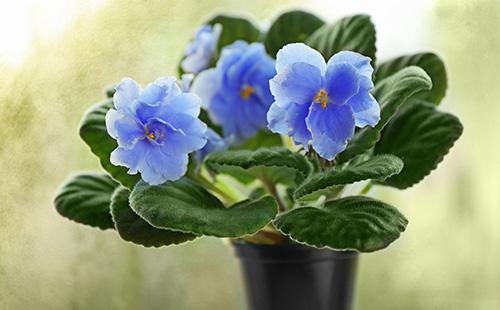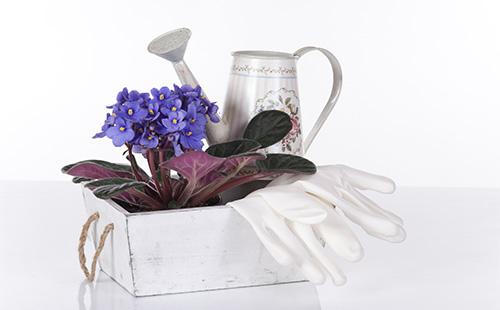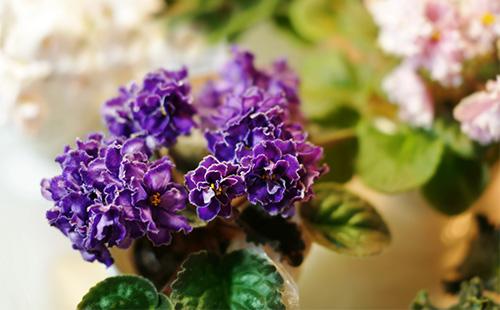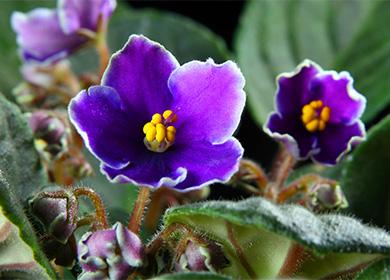The content of the article
Violets form a compact bush with flowers of different colors and shapes. Indoor violets belong to the family of Gesneriaceae, and not violet. They are familiar to many under the name "senpolia".
Appearance, features and varieties
They bloom for a long time - up to ten months a year. In summer, usually relax. The bush is a dense rosette of leaves. Leaflets are dense, rounded, with dense pubescence. They grow from a short stem hidden by greenery, or directly from the root. Five-leafed flowers, sitting on long peduncles.
Violet blooms with flowers of various shapes and colors. Flowers are double or simple, plain or multi-colored. Often, stains, specks, edging with contrasting colors are present in the coloring. Among violets varieties with charcoal-black expressive flowers are found.
Foliage is often plain, dark or light. Hybrid variegated varieties look very beautiful - with spots, strokes, edging of different shades. In total there are over 200 varieties. Therefore, the cultivation of violets at home for many turns into a real hobby.
A common sign of all types of violets - the leaves are collected in a dense basal rosette. Otherwise, they are very different:
- flower shape - It is limbic, fantasy, classic, star-shaped. apart are the violets of the chimera;
- the petals - are simple, semi-double or double;
- flower coloring - distinguish monophonic and multicolor varieties;
- leaf shape - there are varieties with round, oval, elongated leaves. the edges may be smooth or jagged;
- leaf color - light, dark or variegated (variegated);
- the size - emit miniature, microminiature and giant varieties.
Selection recommendations
Usually, adult blooming violets are sold in stores. Buying such a plant is not the best option. Most of the flowers from the windows were brought from other countries, grown exclusively for commercial purposes. After the purchase, they will bloom for about two months, then gradually die. It is more reliable to buy cuttings, but flowering will begin only in a year and confusion with the variety is possible.
If you buy an adult plant, carefully inspect it, ask the seller to provide you with additional information. What you should pay attention to?
- Age. Check with the seller of the country of delivery of the violet. Do not buy a plant older than a year. It is advisable that the violet be grown in a local climate.
- Stem. In an adult healthy plant, it should not be visible. Yellowing, lethargy of the stem, traces of fallen leaves are signs of an old or diseased plant.
- Socket. The violet socket is symmetrical, dense.
- Leaves. A healthy leaf is uniformly green except for variegated (variegated) varieties. Speckles, spots, yellowing, plaque indicate illness.
- Substrate. A grayish coating on the substrate indicates fungal diseases or lack of drainage, poor breathing of the root system.
Acclimatization
Caring for violets after purchase is aimed at creating favorable conditions for the quick adaptation of the plant in the new microclimate. Compliance with all of the recommendations below increases the likelihood of a good survival rate of violets.
- Fungicide treatment. In the early stages, fungal diseases are almost invisible. They develop rapidly, often leading to the death of a flower. Immediately after purchase, treat the violet with a systemic fungicide. The drug "Maxim" has proven itself well. It is diluted with water in accordance with the instructions, a flower is sprayed from a small spray bottle. After 15-20 minutes, the remaining moisture from the leaves is carefully removed with a paper towel. The earth is watered with an Aktara insecticide solution.
- Quarantine. Violet is isolated from other plants for two weeks. If possible, place it in an empty aquarium, cover with glass or film on top. Condensate is removed daily from the walls of the aquarium.
- Transfer. It is worth transplanting the violet in two cases - the roots come out through the drainage hole and the poor condition of the soil. They use the method of transshipment (without destroying the old earthen coma), the roots try not to disturb.

Basic care rules
Violets are capricious in that they require the creation of favorable conditions. Otherwise, the flower easily rots and succumbs to pests. It is recommended to adhere to at least the basic rules of care.
- Lighting. Lighting is moderate without direct sunlight. Optimal - the north window plus artificial lighting. On the sunny side they put not on the windowsill, but a little away from the window.
- Temperature. In winter, temperature drops below 16 ° C are not allowed. Favorable temperature in the summer is 20-25 ° C. The room is systematically ventilated, but the formation of cold drafts is not allowed. Temperature differences are undesirable. Take out the violet on the balcony is not worth it even in warm weather.
- Watering. Watering violets is necessary taking into account the temperature and humidity. Tap water is pre-settled. Preference is given to filtered or melt water. The average intervals between irrigation are three to four days in winter, one to two days in summer.
- Humidity. Maintain at the level of 50-60%. To increase humidity, use any methods other than spraying. Drops of moisture leave spots on the pubescent leaves of violets.
- Top dressing. In winter, once applied organic fertilizer. In the summer they do not feed, in the spring and autumn they are fertilized with mineral complexes no more than two to three times per season.
- The soil. Soil is needed nutritious and loose. You can buy a ready-made earth mixture or make it from sheet earth, peat and coarse sand in a ratio of 5: 3: 1. Useful additives - no more than 10% activated carbon and slightly crushed sphagnum.
- Transfer. Violets are not transplanted often - with a frequency of three years. Annual transplantation is allowed, but not welcome - the root system of the plant is very sensitive. In advance, you need to take care of growing new plants to replace the old.
Wick irrigation system
It is undesirable to use standard watering methods. Specialists recommend wick watering of violets. As a wick, use a synthetic cord that absorbs water well.
Step-by-step instruction
- Make drainage holes at the bottom of the pot.
- Take a piece of cord about 20 cm long.
- Thread the cord through the hole and lay in a circle at the bottom of the pot. The diameter of the loop should be less than the diameter of the pot.
- Fill the pot with the substrate.
- Place it in a pallet with a depth of up to 10 cm of smaller diameter. The bottom of the pot must not touch the bottom of the pan.
- Pour the soil with water until completely wet.
- Drain excess water from the pan.
- Plant a violet in a pot.

Lack of flowering and its stimulation
If the violet does not bloom, then the conditions of detention are violated. The following care errors result in the absence of flowering.
- Dim lighting. You can determine the lack of light by the leaves raised up.
- Short daylight hours. Daily violet should be lit at least 12 hours a day. In the dark, they are sure to organize additional lighting.
- Lack of nutrition. It is best to use fertilizers designed specifically for violets. They can be found in any flower shop.
- Wrong watering. Flowering is adversely affected by irrigation with hard and cold water, frequent or constant waterlogging of the soil.
- Dense soil. In heavy soil, the root system develops poorly, it is difficult to absorb nutrients.
- The big pot. In a spacious pot, violet directs forces to the development of roots and the growth of leaves. In close - for flowering.
- Pests or diseases. The absence of flowering can lead to the initial stages of disease or an attack of pests.
As a stimulation, try feeding violets for abundant flowering, transplant the flower into a closer pot, and eliminate the errors of care. For prevention, treat with fungicide and insecticide.
Breeding methods
Most common is the propagation of room violet leaves. There are other ways - stepchildren and seeds. The seed propagation method is ideal for growing a new variety.
From sheet
Growing a room violet from a leaf is easy. Leafy cuttings take root quickly. From one leaf you can get several young plants at once. The sheet is taken from the middle row. The best time for breeding is spring. The leaf is cut along with the petiole up to 5 cm long. Rooted in water or soil.
- Rooting in water. A cut of petiole is immersed in water by 1 cm. To prevent rotting of the cuttings, a tablet of activated carbon is added to the water. It inhibits the development of pathogenic microflora. Water is periodically changed. After the appearance of the roots, they are transplanted into light soil. Systematically watered, do not allow the substrate to completely dry out. About a month later, children form at the base of the petiole.
- Rooting in the soil. Leaf stalks are planted in moist soil. Holes are made in polyethylene, they are covered with a landing bowl with cuttings. Maintain stable humidity.
Stepsons
The stepsons of violets are daughter sockets in the form of a small process. He appears from the axils of the leaves. They spoil the appearance of the bush, so usually they are simply cut off. But you can pinch the top of the process and wait a bit.
When four to five leaflets form on the stepson, it is carefully cut and rooted in the ground. The rooting conditions are identical to the leaf cuttings - perforated film, systematic hydration.
From seed
Seed propagation takes longer, but allows you to get a large number of plants at once. To propagate your violet, it is easier to root a leaf stalk. But growing a new variety is much more reliable than buying an adult violet in a store.
For landing, take low containers filled with loose soil. Seeds do not close up - they are simply spread over the surface of the moistened substrate. The container is covered with film and white paper. They are kept in a moderately warm room 17-21 ° C, periodically airing the greenhouse.
Seeds germinate quickly, in just two or three weeks they form real leaves. At this stage, they are carefully transplanted into a larger container. They grow ripe violets under glass. Fortified plants are planted in individual pots.

Major diseases
Violet is not disease resistant. Any disturbance of the conditions of detention, proximity to a diseased plant or contaminated soil can lead to the development of diseases. It is possible to save the violet only with timely treatment. In the table you will find data on the most common diseases and how to treat them.
Table - Common Violet Diseases and Treatment Methods
| Disease name | Symptoms | Treatment methods |
|---|---|---|
| Fusarium | - Rotting of the roots; - rotting of the stem; - blackening of the roots; - brown spots on petioles; - leaf fall | - Removal of diseased leaves; - processing "Fundazolom" |
| Powdery mildew | - Whitish bloom; - yellowing of the leaves; - leaf drying | - Single treatment with Benlat (If necessary, repeat after 10 days) |
| Late blight | - Brown spots on the leaves; - root rot rot | - late blight is not treated |
| Gray rot | - Fluffy brown coating | - Removal of diseased leaves; - fungicide treatment |
| Rust | - Orange mounds on the leaves; - rash of spores from the hillocks | - Processing Bordeaux liquid; - sulfur dust treatment |
| Vascular bacteriosis | - Glazing of leaves; - death of leaves | - Treatment with Zircon, Previkur, Fundazol |
Typical pests
Pests move from diseased plants or can manifest themselves some time after buying violets. Violation of the regime of care contributes to their development - too dry or humid air, excessive or insufficient watering. All the necessary data on pests and control measures can be found in the table.
Table - Common pests of violets and ways to combat them
| Insect name | Signs of defeat | Ways to fight |
|---|---|---|
| Ticks | - browning leaves; - thin web; leaf deformation | - Treatment with acaricides "Actellik", "Fitoverm" |
| Shield | - Sticky discharge; - small plaques | - Treatment with Agravertin |
| Thrips | - Holes on the petals; - destruction of stamens; - brown spots on the leaves | - Removal of diseased parts; - treatment with the insecticide "Inta-vir" |
| Nematodes | - Microscopic worms on the roots; - swelling on the roots; - light spots on the leaves; - decay of leaves; - lack of growth; - lack of flowering | - Removal of affected parts; - nematicide "Vidat"; - transplant |
| Root worm | - Sour smell; - white lumps on the roots | - transplantation; - root treatment with Aktara |
| Aphid | - Twisting leaves; - deformation of the petals; - wilting buds; - weak flowering; - sticky coating | - Treatment with soapy water; - “Mospilan”, “Actellik” |
| Cats and mosquitoes | - Rot of roots, leaves, stems; - small flying insects | - Watering the soil "Karbafosom" |
| Whitefly | - Brilliant plaque on the leaves; - black coating; - light leaves; - growth cessation | - The combination of insecticides with acaricides |
Since caring for a violet is not easy, before you buy this plant, calculate your strength and time. Violet requires a careful and attentive attitude.

